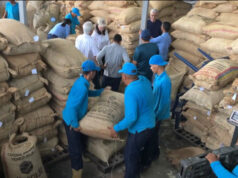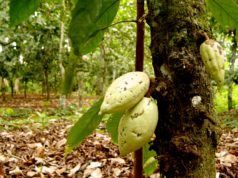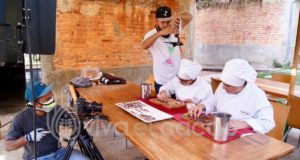For chocolate producers and master chocolate makers, these words are part of their usual language, but what about the rest of people who go crazy for a good chocolate and are anxious to know more about cocoa and chocolate jargon?
From Vivaelcacao.com, and by the hand of the Agricultural Engineer from FUNDACACAO, Andreina Portillo, we invite you to satisfy your curiosity and discover the meaning of terms that you may have heard at some point. We assure you that after understanding them, it will be much easier and funnier to be close to an expert and talk about the subject.
- . Analogous of chocolate: It is the uniform product prepared with cocoa powder, vegetable fat, starch, cocoa butter added or not, cocoa liqueur, sugar, sweetener, milk solids and allowed additives (COVENIN 3585: 2000).
- Bean to bar: this trend became popular in North America for more than a decade, and refers to the artisan, but refined, way of making chocolate bars. Hence its literal translation is “from grain to bar”.
- Good Agricultural Practices (GAP): It is a set of principles, standards and technical recommendations applicable to the production, processing and transportation of food, aimed at ensuring the protection of hygiene, human health and environment, using methods ecologically safe, hygienically acceptable and economically feasible.
- Good Manufacturing Practices (GMP): it is a compilation of general rules, procedures and practices that together provide a guide to what is acceptable and unacceptable within the food industry.
- Cocoa: It is a tropical tree from the Amazon jungles. It has a dense crown, the adult leaves are completely green, its flowers, on the stem or branches, are white or rosy, the fruit is a pod. The cocoa tree usually reaches a height between 6 to 20 metres.
- Criollo cocoa: It is characterised by a fruit often elongated, with a prominent, bent and sharp end. Its surface is generally rough, thin, and often green splashed with red or dark purple and marked by 10 very deep grooves. The beans are large, thick, almost round with white or very slightly pigmented cotyledons (Navarro and Mendoza, 2006). It is the type of cocoa with more flavour and aroma of all.
- Cocoa slime: It is the cocoa bean after being harvested and placed in a plastic container with a capacity of approximately 18 kg. This container is called a cocoa can. The yield rate of each can of cocoa should be between 6.2 to 6.5 kg of dry cocoa.
- Extra-fine cocoa: It is the cocoa bean obtained from a variety of trees called “criollos”, with soft, pinkish white cotyledon almonds, whose beans are well fermented (higher than 70%), with almost circular cross-wise section, and that complies with the established requirements, free of odours different from its characteristic one as well as any other adulteration sign.
- Fine aroma cocoa: according to Álvarez et al. 2007, it is defined as almonds with high aromatic potential and other sensory benefits that make them so different from others. The Fine cocoa has distinctive aroma characteristics and low content of bitter substances.
- First class fine cocoa (fermented or F1): It is the cocoa obtained by fermented hybrid beans from cocoa Trinitarian Forestero (also called Forestero in Venezuela) that have been fermented to a degree greater or equal to 80%. Free from unusual odours and any other sign of adulteration.
- Second class fine cocoa (fermented, common, ordinary, or F2): It is the cocoa obtained by hybrid beans from Trinitarian Forestero cocoas (also called Foresteros, in Venezuela), which differ from the first class fine cocoa in the fermentation degree, since its beans have not been fermented or the process has been done in an inappropriate way.
- Forestero cocoa: Its fruit is generally oval-shaped and short, green or yellow when is ripe, with a smooth surface. The pericarp is thick and difficult to cut. Its beans are small and kind of flat and its colour is between light and dark purple (Navarro and Mendoza, 2006). They are more resistant to the environment and the plagues, but their flavour and aroma are not as remarkable as it is Criollo cocoa.
- Trinitarian cocoa: It is a hybrid between Criollo and Forestero. The Trinitarian cocoa shares characteristics from both groups. The colour of the almonds varies between the white from the Criollo and the dark one from the Forestero (Navarro and Mendoza, 2006). Likewise, they hold aromatic features much more relevant than the Forestero.
- Cauliflorous: Cocoa is cauliflorous, since its flowers and fruits are produced on the stem and branches of the tree.
- Chocolate: It is the homogeneous product prepared from cocoa liqueur, cocoa butter, with or without added sugar, sweeteners, milk solids, vegetable fat up to 5% and allowed additives (COVENIN 52: 1999)
- White Chocolate: I is a kind of chocolate made with cocoa butter combined with milk powder and sugar. It does not use cocoa liqueur in its preparation.
- Milk chocolate: It results from the combination of cocoa liqueur, cocoa butter, milk powder and sugar. It contains approximately 35% of cocoa liqueur. Its main ingredients are milk powder and sugar.
- Cup Chocolate: It is a dark chocolate with a little starch added, so it can thicken. Normally it dissolves in milk.
- Dark chocolate, black, bitter or bitter: It is the result of the combination of cocoa liqueur, cocoa butter and sugar. It must contain at least 45% of cocoa liqueur.
- Chocolate coating: It is used by bakers and chocolate makers to make desserts. It is chocolate with a content of 30% of cocoa butter.
- Conchage: It is the process of intense stirring and ventilation of the chocolate paste for several hours at a temperature ranging from 70 ° C to 90 ° C.
- Orthotropic growth: vertical growth of the cacao tree.
- Plagiotropic growth: horizontal growth of the cacao tree.
- Cocoa derivatives: products obtained from the husked cocoa, such as: cocoa paste, cocoa cake, cocoa butter as well as mixtures of these products with sugar and / or optional ingredients.
- Husking: It is the removal of the almond shell either manually or mechanically.
- Fermentation: It is the process of eliminating the slime or mucilage of cocoa and the production (within the almond) of precursor substances of chocolate flavour and aroma.
- Cocoa bean: It is the almond inside the cocoa pod, healthy, clean, already fermented or not, dried, husked and without mucilage (COVENIN 50: 1995, 2nd revision).
- Fermented bean: It is the almond that when cut lengthways by the cross section, shows on both sides of the almond well defined and deep grooves, with a very fragile dark brown husk (forestero and trinitarian cocoas) and light brown (Criollo cocoas ).
- Germinated bean: It is the cocoa bean whose husk has been broken by the growth of the seed radicle, exposing it to the attack of fungi and insects (COVENIN 50: 1995, 2nd revision).
- Mouldy bean: It is the bean showing moulds in its internal or external parts which can be seen at a glance (COVENIN 50: 1995, 2nd revision).
- Partially fermented bean: This is the cocoa bean which, when cut lengthways by the cross section, shows shallow grooves on both sides of the almond, compacted edges, mildly fragile dusky red-brown husk (Trinitarian and forester cocoas) and light brown (Ciollo cocoas).
- Slaty bean: it is the cocoa bean, when is cut lengthways by the cross-section, shows a smooth and compact texture mass, generally in slaty or dark colour (COVENIN 50: 1995, 2nd revision).
- Flat grain or “pasilla”: It is the cocoa bean whose two cotyledons are so fine that it is not possible to obtain a cotyledon surface when it is cut, meaning that the thickness between its two flat faces measures less than 5 mm. (COVENIN 50: 1995, 2nd revision).
- Grains damaged by insects: This is the cocoa bean showing insects inside or outside, detected at any stage of development (eggs, larvae, adults) or that it has been attacked by insects damaging the almond observably (COVENIN 50: 1995, 2nd revision).
- Dry cocoa beans: It is the grain which has been uniformly dried and whose moisture content is between 7 to 8% (COVENIN 50: 1995, 2nd revision).
- 36. Pod index: It is the quantity of pods needed to obtain 1 kg of fermented or non-fermented and dried cocoa.
- Seed index: It is the average weight of 100 beans of fermented or non-fermented and dried cocoa.
- Grafting: It is the most used asexual propagation in cocoa cultivation. It consists in joining a bud of a tree (crown) with ideal features with a plant (pattern) produced in a nursery, which is more resistant to the effects of unfavourable conditions. The new plant will be similar to the one where the bud was taken.
- Innocuousness: it is the guarantee that the product will not cause any harm to the consumer, when it is prepared or ingested, depending on its intended use.
- Cocoa liqueur (dough or cocoa paste): It is the product obtained by grinding fermented or unfermented cocoa beans, roasted, husked, without germs and contaminants (COVENIN, 1480: 1998, 2nd revision).
- Processed cocoa liqueur: It is the product obtained by grinding the fermented or unfermented cocoa beans, roasted, husked, without germs and contaminants, which may or may not be added alkaloid, acidifier and emulsifier agents (COVENIN, 1480: 1998, 2nd revision).
- Linalool: It is a terpene with an alcohol group whose natural form is common in many flowers and aromatic plants. This component of the volatile part of cocoa plays an important role in the perception of the floral characteristic and is commonly known as “Arriba” flavour, a unique feature of the National variety.
- Cocoa butter: It is a semi-solid product, with a greasy aspect at room temperature, white or slightly yellowish, obtained from the processing of cocoa beans through mechanical extraction or by solvents.
- Alien bodies and matters (contaminants): It refers to any substance other than cocoa beans, such as cord pieces, stones, insects and wood or stick bits, among others.
- Cocoa nibs: They are pieces or tips of roasted cocoa obtained after the seeds are toasted and husked, and finally crushed or chopped.
- Drying yard: Area for drying the beans either after fermentation or harvesting. These are usually built in cement or softwood.
- Pruning in cocoa: This is a technique used to eliminating all shoots and unnecessary branches, as well as the damaged and dead parts of the tree. It is a quite important cultural work due to its direct effect on the growth and production of this crop.
- 48. Cocoa powder: It is the product obtained by the pulverization of the cocoa cake.
- Cutting test: It is a method of cutting the cocoa beans lengthways and performing a visual analysis of both sides of the cotyledon in order to establish any possible defect as well as the fermentation degree (COVENIN, 424-1995).
- Drying: It is a stage in the cocoa processing in which any excess of moisture is removed from the beans by heating and the formation of chocolate aroma and flavour is completed.
- Tempered or warmed-up: It is the process by which the chocolate undergoes several temperature variations in order to cause the crystallization of the fat (cocoa butter) which is formed by four crystals: Gamma, Alpha, Beta and Beta `.
- Cocoa cake: It is the product obtained from isolating the butter and the cocoa liqueur by pressure (COVENIN, 1479: 1998, 2nd revision).
- Traceability: It is the ability to follow the history, application or location of everything under consideration. It is the monitoring of the origin of materials and parts, the processing, distribution and location history of the product after delivery (ISO 9000: 2000).
- Tree to bar: It means “from the tree to the bar”. In this way it is necessary the correct application of good agricultural practices.
- Cocoa nursery: It refers to the place where cocoa seedlings are previously formed, for its subsequent planting in the final soil.









https://vivaelcacao.com is very informative, bookmarked
https://vivaelcacao.com is very informative, bookmarked
Comments are closed.